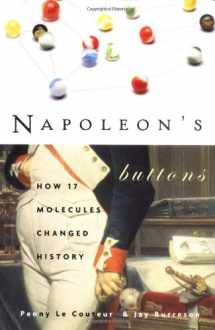
Napoleon's Buttons: How 17 Molecules Changed History
Book details
Summary
Description
Though many factors have been proposed to explain the failure of Napoleon's 1812 Russian campaign, it has also been linked to something as small as a button-a tin button, the kind that fastened everything from the greatcoats of Napoleon's officers to the trousers of his foot soldiers. When temperatures drop below 56°F, tin crumbles into powder. Were the soldiers of the Grande Armée fatally weakened by cold because the buttons of their uniforms fell apart? How different our world might be if tin did not disintegrate at low temperatures and the French had continued their eastward expansion!
This fascinating book tells the stories of seventeen molecules that, like the tin of those buttons, greatly influenced the course of history. These molecules provided the impetus for early exploration and made possible the ensuing voyages of discovery. They resulted in grand feats of engineering and spurred advances in medicine; lie behind changes in gender roles, in law, and in the environment; and have determined what we today eat, drink, and wear.
Showing how a change as small as the position of an atom can lead to enormous differences in the properties of a substance, the authors reveal the astonishing chemical connections among seemingly unrelated events. Napoleon's Buttons offers a novel way to understand how our contemporary world works and how our civilization has been shaped over time.


We would LOVE it if you could help us and other readers by reviewing the book
Book review



